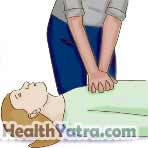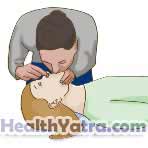সংজ্ঞা
Cardiopulmonary resuscitation (CPR) is a series of steps to help a person who is not responding and has stopped breathing. CPR helps deliver oxygen rich blood to the body tissue when the body is not able to do this on its own.
পদ্ধতির কারণ
CPR is given to a person who is not responding and has stopped breathing. Reasons for this may include:
- Sudden cardiac arrest
- Cerebrovascular accident (eg, stroke)
- ট্রমা
- দম বন্ধ করা
- ডুবে যাওয়া
- Electrical shocks and lightning strikes
- মারাত্মক সংক্রমণ
- Severe allergic reaction
- Drug overdose
- অত্যধিক রক্তপাত
- হাইপোথার্মিয়া
The outcome will depend on the initial cause and how soon effective CPR was started. Many victims are unable to regain a normal heartbeat after it has stopped.
সম্ভাব্য জটিলতা
The goal of the CPR is to provide blood flow to a victim’s heart, brain, and other vital organs until proper medical care can be given. The victim is likely to die if CPR is not started immediately. Complications may include fracture of the ribs, broken teeth, infections, and puncture of the lung.
People with weakened bones have a higher risk of bone fractures from CPR. However, there is a greater risk of death if CPR is delayed or not done correctly.
What to Do
পদ্ধতির আগে
When you see someone collapse or find someone unconscious, immediately check to see if the person is responsive. Tap the victim and ask: “Are you OK?�? If the victim is unresponsive, follow these steps.
- If you are alone, call for medical help right away. If someone is with you, have that person call for medical help right away and get the automatic external defibrillator (AED). An AED is a device that delivers electric shocks to the victim’s heart.

If the person is not breathing or only gasping, begin CPR by doing chest compressions:
- Place the heel of one hand palm down on the chest with the other hand on top.
- Straighten your arms and lock your elbows. Begin pressing down in a straight motion. The compressions should be at least two inches deep.
- Push hard and fast at a rate of 100 compressions per minute.
- Allow the chest to rise completely between compressions.
- Avoid interruption between compressions.

- If you are trained in CPR, give two rescue breaths after 30 compressions. To give rescue breaths:
- Open the airway by placing one hand on the forehead and lifting the chin with your other hand.
- Gently tilt the head backward. Pinch the victim’s nose and cover his mouth with yours.
- Breathe twice into his mouth until you see the chest rise. Breaths should be about one second each.
- After giving two rescue breaths, do 30 compressions. Continue the cycle of two breaths and 30 compressions.
- If you are not trained in CPR, continue doing the chest compressions without giving rescue breaths.
- Give CPR until the AED is brought to the scene or until:
- Medical help arrives.
- It becomes unsafe to continue.
- The victim is conscious and able to breathe.
- To use the AED:
- Turn the AED on.
- Attach the pads.
- Follow the prompts. If advised, deliver the shock. If the shock is not advised, the AED will tell you to resume CPR.
কতক্ষণ এটা লাগবে?
The length of time for CPR depends on the causes and response time of the emergency medical team.
Will It Hurt the Victim?
The patient is unconscious when CPR is given. The procedure does not hurt. Some patients may complain of soreness in the chest after they are conscious.
পোস্ট-প্রক্রিয়া যত্ন
The patient should be taken to the hospital. He should go even if he has recovered. Emergency personnel will take over care when they arrive.
Call For Help
If a teen or adult is unresponsive, call for medical help right away. If someone is with you, have that person call for medical help right away while you begin CPR.
